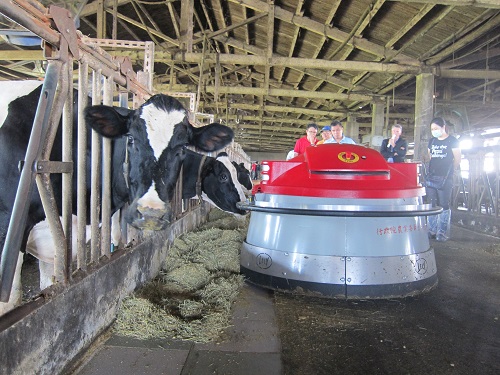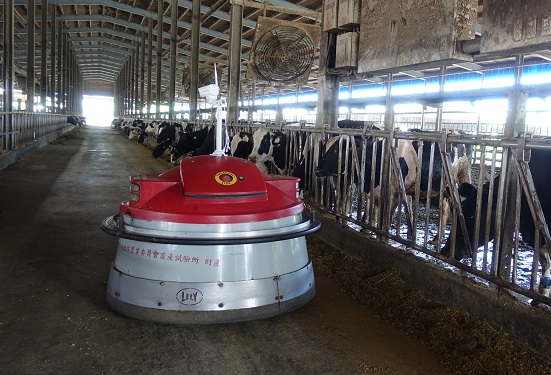Author: Yi-Hsuan Chen, Assistant Researcher, Hsinchu Branch, Livestock Research Institute, Council of Agriculture, Executive Yuan
The robotic feed pusher is a smart forage-feeding intelligent with a power-saving device had been introduced to Taiwan by Livestock Research Institute in 2017. The internal 12-volt battery in the pusher could provide 2 hours of pushing time. When the battery capacity is low, the pusher would automatically return to the charging station to rechargeing itself. Furthermore, the pusher could adjust the pushing pilot by ultrasonic induction on farm fence site or wall. If there are no fence or wall in the barn, the pusher could push alone the iron piece embedded on the ground. In addition, the pusher could be controlled remotely to execute the walking function by the mobile device such as smart phone or tablets through Bluetooth.
 Fig.1. The pusher replaces the manpower requirement on the dairy farm.
Fig.1. The pusher replaces the manpower requirement on the dairy farm. After importing the pusher to dairy farms for the demonstration, it has effectively replaces the manpower requirement of 3 to 4 hours per day (Fig.1), and increases the eating times and intake of the cows. Therefore the milk yield has stably increasing by 3 to 8%. At present, the pusher have been introduced to the demonstration dairy farms in Changhuacounty. The pusher could push the forage closer the cow more than 8 times per day, it will increase feed intake and reduces feed waste. With help of the pusher our workers have more time to be spent on other important jobs. After the introducing of the pusher, it efficiently replaces traditional manual pushing job and leads to more stable ruminal pH in dairy cows by a small amount of meals. At the same time, it can help to reduce ketosis from happening especially in the sub-tropical and tropical weather of Taiwan. Therefore, through multiple pushing times by the pusher at night at night during the summer, the cow could eat more and stable feeding in the demonstration field. According the farmers of demonstration field have described, with the introducing of the pusher the milk production of their dairy cows has increased significantly. We compared the milk production of dairy cows raised at Hsin-Chu Branch, Livestock Research Institute before the use of the pusher in 2017 and after the pusher was introduced in 2018(Table 1 and 2). The result showed that the milk yield of dairy cows was higher in 2018 than in 2017.
 Table 1. The average milk production (Kg/ cow/ day) of dairy cows at Hsin-Chu Branch, Livestock Research Institute before (2017) and after (2018) the introduced of the pusher.
Table 1. The average milk production (Kg/ cow/ day) of dairy cows at Hsin-Chu Branch, Livestock Research Institute before (2017) and after (2018) the introduced of the pusher. Table 2. The average milk price ($NTD/ month) of dairy cows at Hsin-Chu Branch, Livestock Research Institute before (2017) and after (2018) the introduced of the pusher.
Table 2. The average milk price ($NTD/ month) of dairy cows at Hsin-Chu Branch, Livestock Research Institute before (2017) and after (2018) the introduced of the pusher.In order to monitor the situation of feeding cattle in the farm by the push-feeding robot, we created and integrated the current Web Camera (network camera) monitoring device as the eye based on the existing Wi-Fi wireless network built by the dairy farm. Through the Internet, the farmer can monitor the feeding of cattle at any time through the mobile application software. They can remotely check the feeding status of the cows from distance. It can also confirm the back of the cattle to identify the feet health of cattle.
 Fig.2. The WiFi vision system on the pusher provides farms with security monitoring service.
Fig.2. The WiFi vision system on the pusher provides farms with security monitoring service. In addition to the instant information on feeding, the Wi-Fi vision system also has the function of pasture preservation. On the route of pushing, the farmer could control the Wi-Fi vision system to check the current situation of the farm in a 360-degree angle through the APP. The general webcam equipment is powered by USB or DC 5V transformer. However, the robot has no power supply when it’s working. In order to overcome the power supply problem of the network camera, we think about modularized design and modularized relay. The robot battery is provided with the power of the webcam device by elastic clamp disassembly and assembly. It has a circuit protection mechanism, so that the Wi-Fi vision system has a 24-hour operation state, and provides farm a security monitoring service (Fig.2). Because the Wi-Fi vision system has set a microphone, it could receive and playback function. Even if the farmer is not in the farm, the farmer could interact with the staff through the device at the scene, without using any handheld or mobile device. Feeding management become more convenient. In addition, the Wi-Fi vision system has a live video storage function. The farmer can directly play back the video content through the mobile device at any time. The memory card can also be removed from the machine to store the video content, which is equivalent to the car's driving recorder.